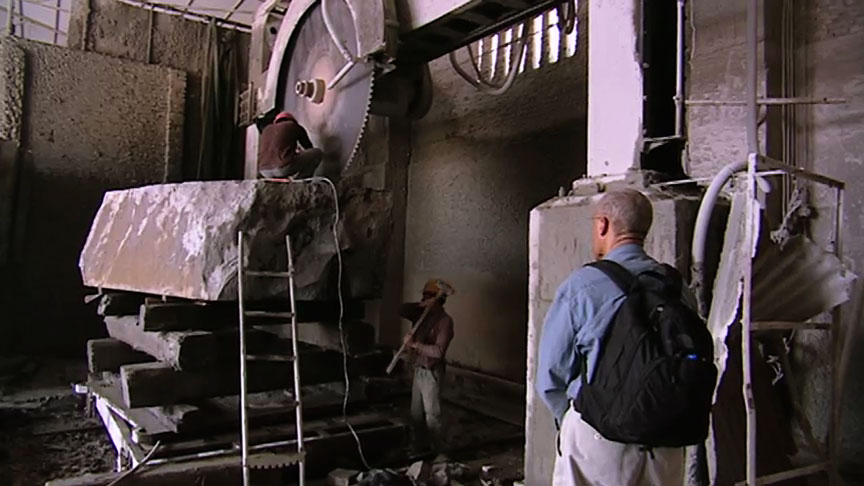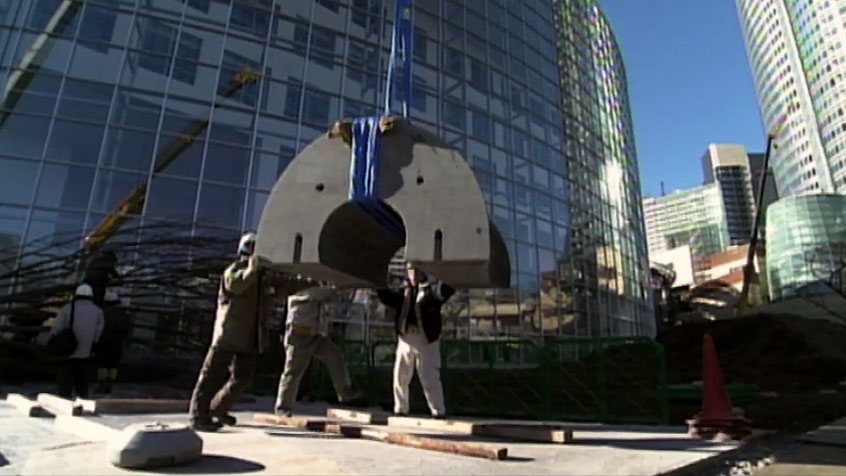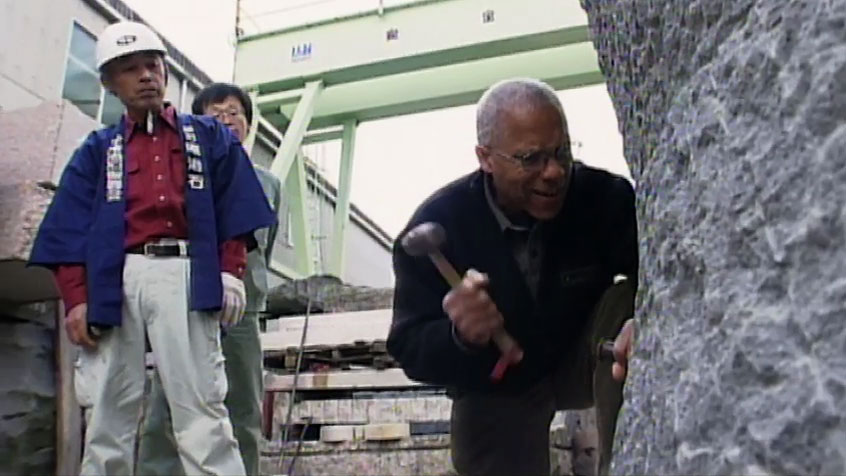Interview
Stone Carving

Martin Puryear's commissioned sculpture in Tokyo, Japan, 2002. Production still from the "Art in the Twenty-First Century" Season 2 episode, "Time," 2003. © Art21, Inc. 2003.
Martin Puryear talks about the process of conceiving, designing, and installing his large stone sculptures.
ART21: What was the process like, for the stone piece in Japan?
PURYEAR: I think the big challenge was that it was a piece that was carved. And I have spent most of my working life making work that may seem to be carved but which in fact is constructed, made from parts and put together. And although this was made from eighteen blocks assembled, essentially the process of shaping the blocks was one of carving from solid material. And I haven’t carved stone since I left college, really. And of course, with a piece of this scale, the carving is done industrially at a big stone fabricator facility and requires diamond tools and water and everything, to do it efficiently.
I had to find a way to really transmit my idea as an artist to artisans and on an industrial scale. Which required making the wooden model at one-tenth scale, which was carved from solid blocks, assembled exactly like the blocks would be assembled in the ultimate stone piece. Because the model was done exactly to scale, the model could be disassembled and the tracings made of each block. Those tracings could be enlarged ten times, and that’s the basis that they used for making the final piece. There was so much that was done through simply just pointing and transmitting ideas through sign language and just sketches and drawings.
The language barrier was not too great. In China, it was a little complicated because I had to translate in two stages. I had a person with me who spoke Japanese and English, and the person at the stone yard spoke fluent Japanese, and he was Chinese. So, it had to go from my person, from Japanese into Chinese. And ultimately, when I was in the stone yard working with the people and trying to make the corrections that were needed to be made, it was really more or less pantomime—just showing them by grabbing a straight edge or by making a sketch and showing them what needed to be changed from what they were doing.
I think that one of the major challenges is the sheer scale of it, the sheer size of working with blocks that large and finding blocks that large. They had to be located in a very remote part of China and then brought to the coast, where they were worked at a city that has a very large stone industry—mostly architectural stone but also some stone carving and fabrication of various stone objects. So, they had the facilities, and I was rather surprised at how low-tech it was. I mean, I guess manpower is very cheap, but a lot of the processes—that I know would have been done in the U.S. using certain kinds of saws that can saw and shape contours in stone—were done there using hammers and chisels. It was really interesting to watch.

A stone yard in Xiamen, China, 2002. Production still from the “Art in the Twenty-First Century” Season 2 episode, “Time,” 2003. © Art21, Inc. 2003.
ART21: How did you specify the type of stone? You didn’t, yourself, go to harvest the blocks.
PURYEAR: No, I didn’t. I was shown a number of samples. The choice of material reduced itself pretty quickly because of just the size of those blocks. There’s not a lot of stone that the Japanese were able to locate that would have produced a lot of blocks of that size. They were quite large. And I had a range of colors that I wanted, and it was a case of looking at the samples and choosing the one that I liked. I liked it quite a bit. It was a fairly monochromatic, rather quiet stone which, when polished, would be close to black. But of course I wanted it to be finished rough, so it has a sort of pale charcoal gray or medium gray color.
ART21: Do other colors come through?
PURYEAR: No, it’s pretty monochromatic. It doesn’t have a lot of activity. What you really see in this stone is the shape that you’re making with it, rather than a lot of surface beauty. It’s just a fairly monochromatic stone, very quiet.

Martin Puryear at a stone yard in Xiamen, China, 2002. Production still from the “Art in the Twenty-First Century” Season 2 episode, “Time,” 2003. © Art21, Inc. 2003.
ART21: How did you conceive a piece for a space that wasn’t yet made?
PURYEAR: For my first visit to Japan, the building was under construction. So, I could see what the context for the work would be. And I’d also been looking sensitively at the drawings. And I had made a model of the building and the space in front of the building.
One of the most important elements, when you’re coming up with a work, is the scale or how big it needs to be. And for me, that’s always been, in some ways, the most difficult but also the most crucial part of a project like that. I’m not comfortable with the idea of decorating a building or putting a piece of sculpture right in front of a building. So, I tend to want to pull it as far away from the building as possible.
And in this case, there was planned a Japanese garden with a traditional feel; it’s a modern garden, but it’s got a traditional feel. And this work would be near the garden, but on the edge and very near where people walk, and actually not so far from where cars drive. So, it’s a place where a lot of traffic goes past it, and I like that. I like the fact that people would actually be walking right past this object, as they walked into the garden to walk into the building. And it’s on a turn in the path, and I had some control over just exactly how the circulation pattern worked around the piece.
And so, by working with the site, the scale of the work kind of suggested itself. And for me, once you pull the work away from the building, it seems more important to make the work be of a scale that makes sense with the human scale, rather than to try to relate it to the size of a given building. I know that architects like to have sculpture in front of a building because—I’ve heard this said—that it humanizes the space. And my own sense is that it’s the job of the architect to make the space human. Sculpture is its own reality, its own thing, and it should have a life independent of the architecture. Perhaps if it’s in a building, it needs to acknowledge where it is. But like I said, I prefer to have work that doesn’t have to relate to a building. So, this relates more to the garden and relates more to the people, hopefully, who are going to be circulating around it.

A scale model for Martin Puryear’s commissioned sculpture inside the artist’s studio, Accord, NY, 2003. Production still from the “Art in the Twenty-First Century” Season 2 episode, “Time,” 2003. © Art21, Inc. 2003.
ART21: Does it reflect any new thinking about your work?
PURYEAR: Well, it’s perhaps an opening to the idea of working more with stone, which I have done previous to this. But it’s been more architectural, more in the way of making benches and designing bases for sculpture. Like the Battery Park project—those columns have stone foundations or bases; the bottom element is granite. And this is really a work that is a sculpture. This is really a work that has no function except to be a shape in space that hopefully will have some kind of a life as art. And so, that’s a different thing. And also, to be working with shapes that are clearly sculptural and that are compound shapes—this was an opening for me. Now that I know where to get the work done and about how the work gets done, I look forward to doing more.
ART21: What metaphors does this work evoke in you—what references to the world?
PURYEAR: I think of it as a monolith. It’s not really, strictly speaking, a monolith because it’s made from eighteen stones. But it’s carved in a way so that it becomes a single contoured unit: a single object, a space. The joints are meant to be quiet. They’re not by any means invisible. They are very visible, but they are meant to be fairly tight. And they were fairly tight. But it really is meant to be a monolith. It certainly suggests a head, a colossal head. And I’ve done various pieces in the past that have been based on that same idea, of an enormous cranium or enormous head. And I’ve been wanting to do something in stone using this kind of form for a long time. That’s about as much as I can say about it, in terms of associations or references that it contains. It’s so much about the work that goes into producing it, for me. And the kind of process that produces it.

Installation of Martin Puryear’s commissioned sculpture in Tokyo, Japan, 2002. Production still from the “Art in the Twenty-First Century” Season 2 episode, “Time,” 2003. © Art21, Inc. 2003.
ART21: Each time you work with a master craftsman, do you feel like you’ve learned something tremendous?
PURYEAR: Yes. Obviously, each time I do. I don’t aspire to be a stonecarver. Nor do I aspire to be a stonemason. I’ve done some stonemasonry, and I have learned enough about that to do that when I need to it myself. But I’ve learned that these people who have these incredible skills—I’ve learned to let them help me with the work rather than try to take it over. And I learned a lot of that from Mr. Domenicali, the stonemason who did the piece on Steve Oliver’s ranch.
They’re much better to work with than to try to master what they know. They know an enormous amount. And I’ve learned a lot of things on my own about how to do things, how to put things together, how to make things. But this is a relatively recent thing—working with people who have expertise and knowledge and the ability to realize work for someone else. And it’s a little bit humbling in a way, to turn your work over to somebody else. It’s a little scary because there’s always the worry about “Are they going to get it right?”
So, there’s a tremendous responsibility for the artist, to develop ways of transmitting information very, very clearly, so there’s little or no room for error. Making models that are very, very accurate. Making drawings that are clear, and then making sure that everything, every detail of it, is understood. Knowing of course that, like any art object, it’s going to be subject to some change as you start to see it take shape in space. Usually there’s not a lot of change, but you always have to reserve that possibility.

Installation of Martin Puryear’s commissioned sculpture in Tokyo, Japan, 2002. Production still from the “Art in the Twenty-First Century” Season 2 episode, “Time,” 2003. © Art21, Inc. 2003.
ART21: Do you want to say anything else about the piece in Japan?
PURYEAR: Just that the choice of material was, in some ways, suggested by the fact that it was Japan, because they have such a tradition of working with stone there. And when I was notified that there was an interest of having a commission of mine in Japan, and when I was informed about where it would be, and who the architect was and so forth, and saw more of the building . . .
Originally they had an idea, having seen my work in books and catalogues, for a certain kind of work, which I felt was much less appropriate. There was an idea that it would be a piece indoors, in the lobby, and possibly a piece outdoors—two pieces. I very strongly felt that the piece needed to move away from the building. As much as I respect the building and the architect—it needed to be out on its own. And not relating to that rather graceful curving glass façade but really be out on its own, in space, more in nature. I feel that my work works better in nature, in some ways, or not relating to a man-made environment, if possible. I’ve done plenty of things in man-made environments, but I’m always more comfortable thinking that the work is going to be in a place that is more garden-like than corporate, if you will.
I had gone to Japan in the early ’80s for a visit of little over a month. I just traveled all over Japan, did a lot of walking—shrines, farmhouses, temples—looking at as much as I could, of the vernacular trades and crafts that you could see there, of all kinds. Just taking it all in. Japan is a society that’s produced an enormous and incredible material culture—which is like falling into a well. I mean, you can get so involved in it. And it’s so deep and so complex and interesting that, as a Westerner, it’s like stepping into tar: you can get really stuck in it and not come out.
I know people who have gotten into Japanese woodworking. The level of craft that’s practiced there is so extraordinary that, if you have the right kind of mind, you really just get pulled along into that. And the results are extraordinary. But it’s also a society where these practices are extremely specialized. And the people who reach that level of mastery are just so—I don’t want to say tunnel vision because that sounds a little bit too negative—but they are extremely specialized. And so, I felt there was something to skirt around. Just at the same time as I was admiring so much of this, I felt that there was already a tendency on my part to be drawn toward different ways of doing things well.

Installation of Martin Puryear’s commissioned sculpture in Tokyo, Japan, 2002. Production still from the “Art in the Twenty-First Century” Season 2 episode, “Time,” 2003. © Art21, Inc. 2003.
And for an artist, it just seems to me, it’s not so important to have that level of technical perfection. It’s important to also have a flow and have things be able to germinate and not get caught in the trap of perfection, because that can be a real trap for anybody who makes things. It can be a real trap. It has to do with a kind of idealized view of the world—that there’s a perfectibility to everything that one does. It’s a complicated thing to talk about. Because also within Japanese aesthetics, there is a whole notion of the imperfect and the spontaneous—this very sophisticated notion of beauty that has some imperfection, or some spirit that’s very close to nature. It’s very complex for Westerners to try to grasp. It isn’t always about absolute and pure perfection and idealism. There’s a whole way that things can flow . . .
The bottom line is: I’m not Japanese. I’m American. And I looked at that with an enormous awe and admiration, and I walked on; I just kept going. I mean, in terms of my own growth as an artist, as a person, certainly I was influenced by it. But I never felt the need to apprentice to a Japanese carpenter or woodworker or stonecutter or anything else. I see it as a place that produces enormous material culture, and I respect it. The thing is, I’ve been influenced by so many things. I’ve seen in the world. I’ve traveled a lot, and I take things in wherever I go. And Japan was a rich place, but it’s not the only place.
The other thing is, I’ve gone through a Western art training, like most contemporary artists in the West and certainly in the United States. So, there’s all of that and all of my exposure to the history of Western art and the art of other cultures. I don’t know if I’d want to pull out any special thread of that that’s been any more influential than others. I have a curiosity about everything.
This interview was originally published on PBS.org in September 2003 and was republished on Art21.org in November 2011.



